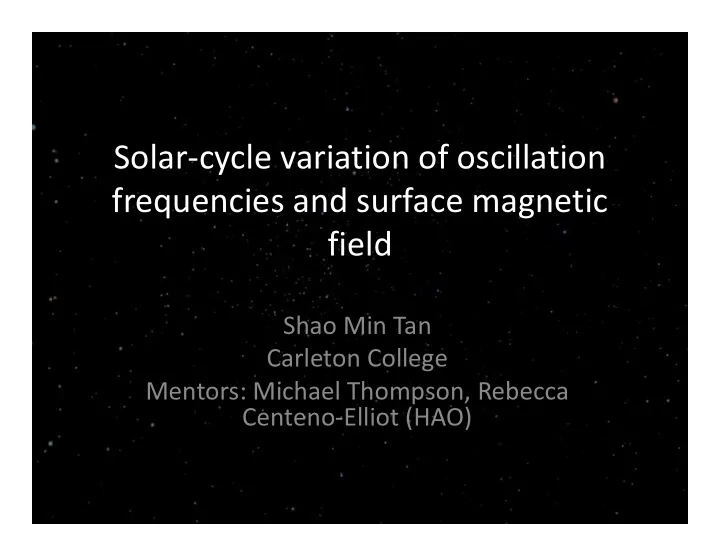

Solar-cycle variation of oscillation frequencies and surface magnetic field Shao Min Tan Carleton College Mentors: Michael Thompson, Rebecca Centeno-Elliot (HAO)
Pulsating Stars Image credit: European Science Agency, http://sci.esa.int/science-e- media/img/20/cepheid-variables.jpg • Cepheid variables • Standard candle
Closer to Home… -2000 2000 -2000 2000 Velocity (m/s) Velocity (m/s) Image credit: Christensen-Dalsgaard, 2002 [1]
Instruments • Michelson Doppler Interferometer (MDI) on SOHO spacecraft • Global Oscillation Network Group (GONG) Image credit: GONG, http://gong.nso.edu/
Solar Oscillations • Oscillation period ~ 5 minutes • Data averaged over 72 days (SOHO) or 36 days (GONG) to find frequencies • p-modes and g-modes
Motivation nspot number Measure of sun Image credit: Broomhall et al., 2009 [2]
Oscillation Modes Radial direction: • Radial order, n Surface: • Degree, l • Azimuthal order, m • Image credit: GONG, http://gong.nso.edu/
Spherical Harmonics l = 1, m = 0 l = 1, m = 0 l = 1, m = 1 l = 1, m = 1 l = 2, m = 0 l = 2, m = 1 l = 2, m = 2 Image credit: Christensen-Dalsgaard, 2003 [3]
Frequency Splitting • Fourier analysis • Legendre decomposition
a k Coefficients over the Solar Cycle
a k Coefficients over the Solar Cycle a 4 a 2 a 6 a 8
Surface Magnetic Field itude Lat Sine latit titude Longitude Image credit: Solar Oscillations Investigation, http://soi.stanford.edu/magnetic/index6.html
Surface Magnetic Field Magnetic flux (G) ude La Sine latitu titude Longitude
Legendre Decomposition of B-field Scaled P k for: k = 0 k = 1 k = 2 k = 3 k = 4 Sum (40 components) = cos θ
B k Coefficients over the Solar Cycle B 4 B 2 B 6 B 8
B k Coefficients over the Solar Cycle B 4 B 2 Image credit: David Hathaway, http://solarscience.msfc.nasa.gov
a k vs. B k a 2 B 2
a k vs. B k a 4 B 4
a k vs. B k – Linear Correlation a 2 vs. B 2 a 4 vs. B 4 SOHO GONG
a k vs. B k over the Solar Cycle Rising phase Declining phase R = -.995 R = -.998 R = -.990 R = -.984 SOHO GONG
a k vs. B k a 2 B 2 a k B k (scaled) a 4 (SOHO data) B 4
Absolute slope of the linear fit lope (nHz/G) My data Absolute slo Antia et al. (2001) [4] Index number, k GONG data
Legendre decomposition at the poles Rising edges (similar to Antia et al.) Flattened edges
Legendre decomposition at the poles Rising edges (similar to Antia et al.) Flattened edges
Legendre decomposition at the poles Rising edges (similar to Antia et al.) Flattened edges
Legendre decomposition at the poles a 2 vs. B 2 a 4 vs. B 4 Flattened edges Rising edges
Conclusion • Linear correlation between a k and B k – corroboration of Antia’s result • Correlation strength is similar for rising and declining phases of solar cycle – what does this mean for subsurface effects? – Further work: separating modes with different penetration depths • Slope varies nonmonotonically with k, regardless of handling of decomposition at poles
References
Recommend
More recommend